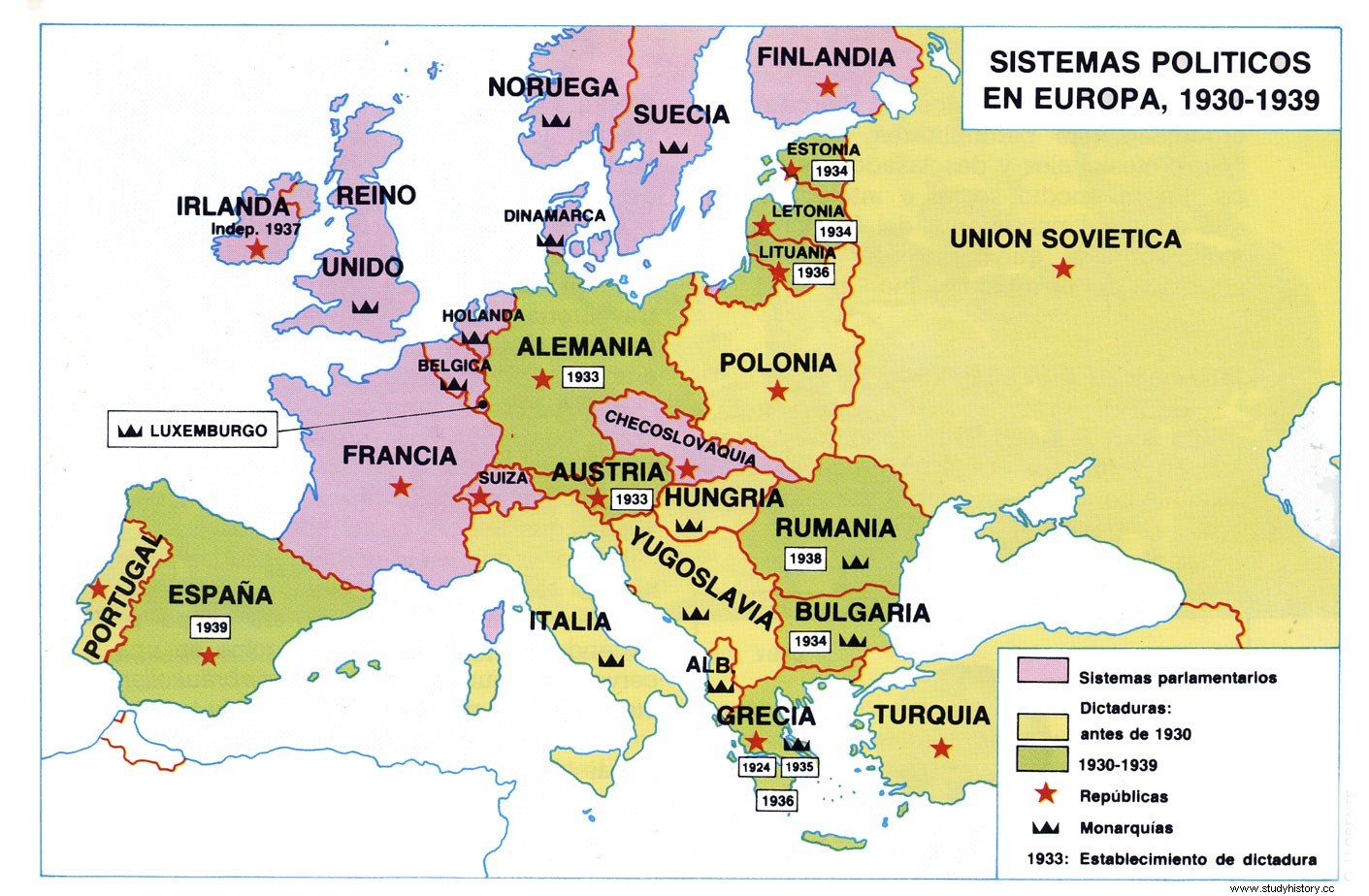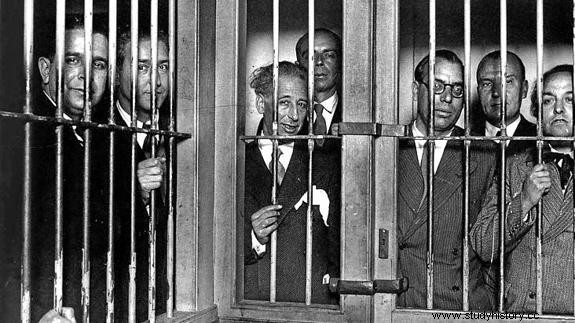Karl Marx's phrase is well known, which says that history always repeats itself twice, first as a tragedy and then as a farce. And signs are beginning to appear that the same is happening with the problem created by the call, by the Catalan government, for a self-determination referendum for October 1. It is true that the specific causes of both events are different, as well as the historical context, especially the international one. But what is striking is the fact that in the only two democratic periods enjoyed by Spain in the contemporary stage, the Catalan question – to call it in some way – has surfaced; and this always from a growth in tension between the central and regional governments. Something very similar happened in 1934.
The political program that the opposition forces agreed upon in San Sebastian provided for attending to the Catalan nationalist demands. But, on the same day that the Second Republic was proclaimed, on April 14, 1931, Francesc Macià proclaimed the Catalan Republic in Barcelona, on his behalf. To redirect the situation, the central government, still provisional, sent three ministers in order to reach an agreement. In exchange for not breaking the structure of the State and withdrawing the proclamation, the government undertook to restore the Generalitat of Catalonia, whose presidency would be held by Macià himself, and to approve a statute of autonomy in the future Constituent Courts.

The 1931 constitution allowed the recognition of the right to autonomy of the regions. Catalonia was the first to begin the process at the initiative of the Esquerra Republicana, which since the 1931 elections had displaced the moderate nationalism of the Regionalist League as the hegemonic party in Catalonia. As a result of the agreement obtained by Macià, a Provisional Deputation of the Generalitat was created, made up of representatives of the municipalities. This Diputación created, in turn, a commission of six members that drafted a preliminary draft of the Statute of Autonomy, which later, on August 6, 1931, was endorsed by 99% of the votes, although women could not vote. On August 18, the project entered the Cortes.
The Statute project adopted a federal philosophy in the territorial conception of the State and proposed a series of powers that contradicted what was stipulated in the 1931 Constitution:creation of a Catalan citizenship, Catalan as the only official language, possibility of incorporating other territories, etc. . These proposals collided with what was said in the constitution because, although the constitution recognized autonomies, the text was based on a unitary conception of the State.
Although the project was reformed to adapt it to the constitution – the exclusive competences in civil law and administrative regime, in the secondary transport network and in health and social services were preserved; and shared in education, public order and finances–, aroused considerable opposition in practically all parliamentary groups. The clearly favorable attitude of Azaña and the political situation created after General Sanjurjo's coup attempt in August 1932 were essential for its approval. September was approved by the majority of the Cortes. The elections called in Catalonia shortly after gave victory again to Esquerra Republicana. When Macià died in December 1933, he was replaced as president of the Generalitat by Luis Companys, who formed a concentration government with left-wing parties.
The electoral victory of the Radical Republicans and the CEDA –November 1933– and their arrival in government in December 1933 explain the appearance of the first conflicts of competence. The first arose with the approval in the Catalan Parliament of the Cultivation Contract Law, which guaranteed a minimum period of exploitation of the land to the tenants (rabassaires ) of the wine sector, as well as the possibility of gaining ownership of them. The Catalan right –the Lliga–, with the support of the central government, presented an appeal of unconstitutionality that was won before the Court of Constitutional Guarantees. This fact was considered by Esquerra Republicana as an attack on Catalan autonomy.
The response of the Generalitat led by Companys must be placed within the framework of the October 1934 revolution. As is well known, the most radical sector of the UGT, led by Largo Caballero, adopted a clearly revolutionary program that was later adopted by the PSOE, but not by the CNT. The entry of CEDA ministers into the government was the trigger for the socialists to start the insurrection, which was justified as a means to prevent Gil Robles from destroying the republic.
To correctly understand these events, it is necessary to situate the European historical framework. In the Europe of 1934 the advance of fascism was consolidating. To the cases of Germany and Italy, we had to add Austria, where Chancellor Dollfuss declared his Patriotic Front a single party and reformed the constitution in a corporatist sense. This example alarmed the Spanish left –the PSOE since the CNT disregarded it–, which took the bourgeois republic for granted and opted for the socialist revolution.

It is also necessary to take into account how widespread the idea was –among the left and the republican center-left– that the Republic could only be governed by the parties of these ideologies. In the electoral campaign of the 1933 elections, the socialist leaders had declared themselves in favor of a socialist revolution. For this reason, the new center-right government saw its legitimacy questioned from the beginning, based on the supposed intention that it wanted to destroy the republic. Macià, then, presented Catalonia as the last bastion of the Republic.
As is already known, the revolutionary insurrection promoted by the socialists failed at the national level –although the general strike was important in some capitals:Madrid, Seville, Valencia, Córdoba, Barcelona…– among other reasons because neither the police nor the army wanted to get involved. The revolutionary attempt was only reflected in two very different phenomena:the workers' uprising in Asturias, and to a lesser extent in the Basque Country, and the nationalist revolt in Catalonia. What united these demonstrations was their attempt to prevent by force the rightward drift of the Republic.
In Barcelona, the general strike of October 5 did not have the support of the CNT. The next day Companys announced the breaking of relations with the central government and the proclamation of the "Catalan State within the Spanish Federal Republic" as a measure against the accession of the CEDA to power. It was not about an independence proclamation but about the creation of a Catalan state within a republican, Spanish state; a complex formula. At the same time he invited the leaders of the revolt to go to Barcelona to form a provisional government.
The measure also entailed a military rebellion whose preparations had been in charge of the Minister of the Interior, Josep Dencás, a curious character close to fascist ideology and a harsh repressor of the anarchists during his time as Minister. The armed popular support that he expected did not manifest in the streets. In addition, Companys failed in his attempt to attract General Domingo Batet, the military chief of Catalonia, who did not obey his orders and occupied the city. On the 7th, Batet placed an artillery battery in front of the Generalitat building and after a small resistance and a brief cannonade from both the Generalitat and the City Council, the Catalan government surrendered. The failed rebellion cost the lives of forty-six people, eight soldiers and thirty-six civilians.

The punishment of those responsible for the rebellion, promoted by the CEDA and a sector of the Radical Party, focused on the socialists, on the figure of Azaña and on the Statute of Catalonia and its representatives. Azaña was arrested and spent a few months in prison for the simple fact that the rebellion coincided with his presence in Barcelona; Meanwhile, an attempt was made to liquidate the Statute, so on December 14 autonomy was suspended indefinitely and the leaders of the autonomous government were prosecuted. Companys and their consellers they were sentenced to thirty years in prison for military rebellion. The soldiers who were in charge of the mossos d’esquadra and the somatén were sentenced to death, although their sentences were later commuted.

The rebellion failed and autonomy was suspended until 1936, when the Popular Front government restored it.
Bibliography.
Casanova, J. and Gil, C (2009). History of Spain in the 20th century . Barcelona:Ariel.
Fernández, J.M., González, J., León, V., Ramírez, G. (2016). History of Spain . Madrid:Santillana.
Fontana, J. (2016). The formation of an identity . Barcelona:Eumo.
Martin, J. (2017). The first Catalan State lasted 11 hours and ended with the Government behind bars. Culture News. Retrieved September 19, 2017, from https://www.elconfidencial.com/cultura/2017-09-06/estado-catalan-1934-proces-cataluna-independencia_1438898/
Nieto, A. (2014). The military rebellion of the Government of Catalonia against the Republic . Madrid:Marcial Pons.
Pericay, X. (2015). The day that Catalonia separated from Spain. Retrieved from http://www.elmundo.es/la-aventura-de-la-historia/2015/09/21/55fff4caca4741491d8b458f.html
Proclamation of the Catalan State in October 1934. (s.f.). In Wikipedia, the free encyclopedia . Retrieved from https://es.wikipedia.org/w/index.php?title=Proclamaci%C3%B3n_del_Estado_Catal%C3%A1n_en_octubre_de_1934&oldid=101751253
